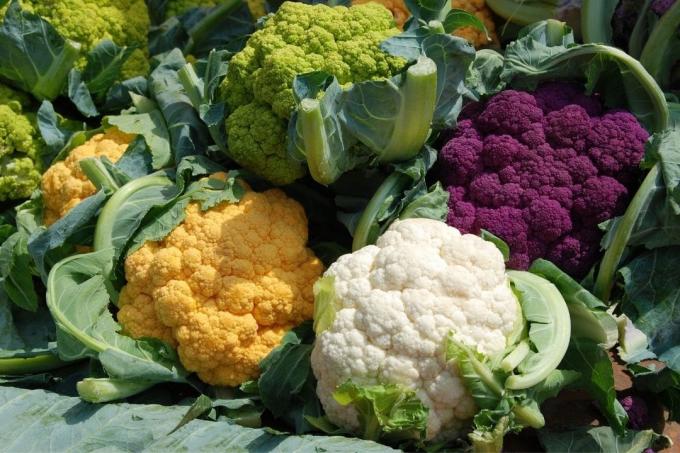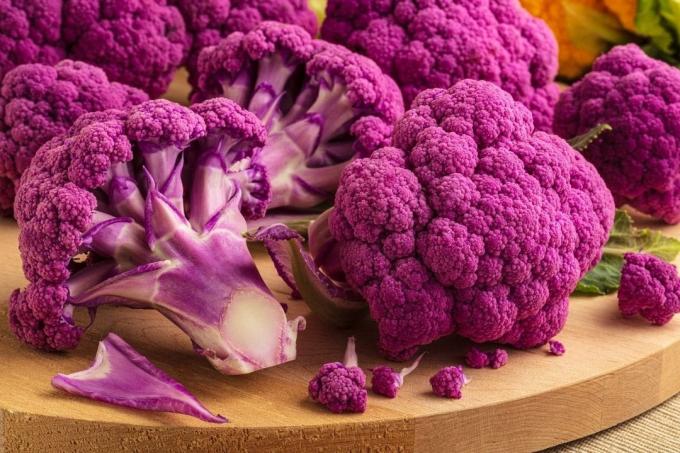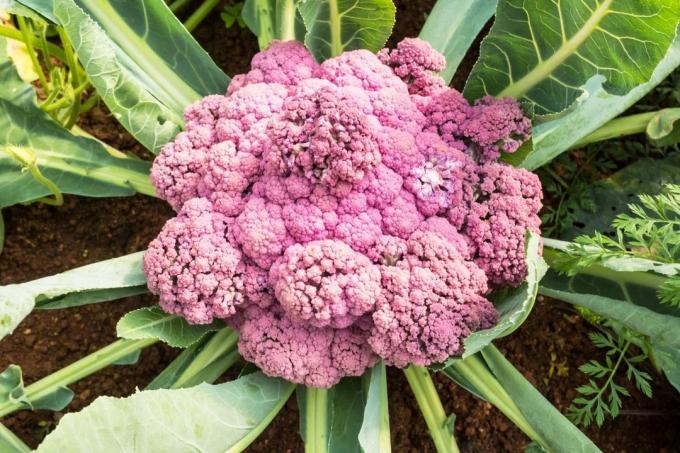
table of contents
- Origin in vegetable cabbage
- Colorful diversity
- Regional preferences
- Health benefits
- Growing purple cauliflower
- frequently asked Questions
Cauliflower (Brassica oleracea var. botrytis L.) is available in a wide variety of colors. Many hobby gardeners rightly ask themselves whether these varieties really only came about through breeding. However, cauliflower hues, such as purple or purple, are a natural color.
In a nutshell
- purple color is a natural coloring
- more healthy ingredients than white cultivars
- especially popular in France and Italy
- are rarely available as plants, but are offered as seeds
Origin in vegetable cabbage
All types of cabbage are based on the wild vegetable cabbage (Brassica oleracea). Through selection based on certain characteristics, these different varieties have crystallized over time. Cauliflower goes back to the 6th Century, when seeds from Italy first crossed the Alps from crusades.

Cauliflower is one of the most popular types of cabbage worldwide. However, cauliflower is rarely colored. The reason for this is that the white variant was created through breeding in which colorless plants were deliberately selected. These were more suitable for trade than colored varieties. In cultivation, however, white cauliflower varieties are more complex than the colored ones, as they need more space to form large leaves. The white flower is only created because the leaves largely protect the flower from excessive sunlight.
Colorful diversity
There are now numerous cultivated forms of cauliflower that differ not only in color, but also in shape. The Romanesco is also a cauliflower, but it forms pointed mini florets. In addition, Romanesco is usually green, but there are seldom varieties in purple.
The cauliflower itself comes in the following colors:
- White
- green
- orange
- purple

The disadvantage of colored varieties, however, is that they usually don't keep their colors when cooked. In terms of taste, there are no disadvantages due to the loss of color. Colorful cauliflower varieties are ideal for fresh preparation as a colorful eye-catcher on the plate.
Regional preferences
While white varieties are popular in German-speaking countries, it looks different in some countries. Colorful cauliflowers are more popular, especially in France and Italy. Especially cauliflower in purple and green is particularly valued. The cultivation of Romanesco is also more widespread here compared to normal cauliflower.
Note: If you want to grow colored cauliflower yourself, you should look for seeds in stores. Brightly colored cauliflowers are rarely used as preferred plants in nurseries or garden centers.
Health benefits
Although the white cauliflower is preferred for its appearance, colored varieties would be much healthier. They contain additional ingredients or the content of ingredients, such as vitamin C, is generally higher than in white varieties.

The high content of colorants in particular is beneficial to health, as they are important substances for preventing cancer and can bind free radicals. Here the purple cauliflower has another weapon against aging caused by free radicals, because sulforaphane can also neutralize free radicals.
Growing purple cauliflower
Colorful cauliflower varieties are more suitable for the autumn / winter harvest and are therefore usually sown later. The sowing takes place, depending on the variety, in June or July.
You can prefer the cauliflower outdoors or in growing trays. Due to the delayed cultivation time, the substrate may well be a bit more substantial. You can mix potting soil with some compost soil. If you use your own compost, you should sterilize it beforehand in the oven.

As soon as the cauliflower plants have formed the first correct pair of leaves, they can be separated. The advantage is that you no longer need the plants prick out must, but can put directly in the bed.
In order for the flowers to be ready in time by autumn, you should pay attention to the following points:
- Row spacing: 60 cm
- Plant spacing: 50 cm
- Loosen the soil
- Incorporate nutrient-rich substrate (ripe compost, deposited manure)
- water well
Note: There are so-called self-covering and non-self-covering types. With self-covering varieties, the leaves grow over the flower, while with non-self-covering cauliflower varieties, the leaves have to be bent over the flower.
frequently asked Questions
Cauliflower generally has a high water requirement. If this is not covered, the flower will be very small or the plants will start to shoot prematurely. Due to the fact that purple cauliflower has more of an open flower that is not protected by leaves, you should expect several liters per day. The actual amount of water also depends on the type of soil and how well it can store water.
Purple cauliflower can only be stored to a limited extent, as it usually loses its color and becomes greenish in the dark. However, late varieties of cauliflower are ideal winter vegetables and can also be left outdoors in winter. Harvesting takes place when necessary when it is frost-free.
Yes, you can freeze purple cauliflower. However, it also loses its color later when cooked and becomes more greenish.

